Abstract
Background: Repair of DNA interstrand crosslinks (ICLs) is considered the major mechanism by which resistance to high and low dose melphalan emerges (
Methods: We compared 51 paired baseline and relapse bone marrow samples for gene expression profiling of CD138 selected plasma cells using the Affimetrix U133 Plus 2.0 microarray. The microarrays were preprocessed using GCOS 1.1 software and normalized using conventional GCOS 1.1 scaling. Baseline and relapse gene expression was compared using the paired Student t test.
Results: More than 30 genes related to DNA repair on the microarray were analyzed. We observed significantly higher expression at relapse of FANCA (p=.003), BRCA 1 (p<.001), CHEK1 (p=.006) and FANCG (p=0.03) (Figure 1). In contrast, FANCD2 was down-regulated at relapse (p=.006), while no significant changes in expression of FANCF or DNA mismatch repair genes were seen.
Conclusion: Our data supports the concept that DNA repair genes in the FA/BRCA pathway contribute to acquired resistance to melphalan in patients after high dose melphalan transplants and that inhibition of DNA repair by bortezomib, gemcitabine or the CHEK1 kinase inhibitor UCN-01, may reverse such resistance if added to high dose melphalan.
DNA Repair Genes in Paired Relapse Samples (N=51)
Disclosures: NIH PO1 and RO1.
Author notes
Corresponding author


This feature is available to Subscribers Only
Sign In or Create an Account Close Modal